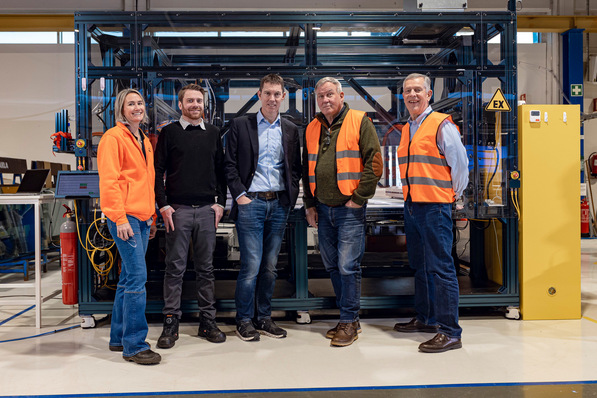Further advantages of dynamic glasses such as high thermal and visual comfort, great potential for energy savings as well as clear, aesthetic lines are increasingly desired in health architecture as well. The latest reference object is a large-scale, smart skylight in the senior care centre Avondzon in Erpe-Mere, Belgium. Realized with the switchable Halio glass system, it serves in many ways as a connecting and health-promoting element.
The importance of biologically effective light
Each year when we change to summertime we notice how much influence light has on our well-being. A mini jet lag throws us some days off track. Many people complain of tiredness, lack of concentration, sleep disorders and depression. This is due to our internal clocks, which cannot adapt to the time zone change immediately. Each organ and almost every cell have one of these timers to clock bodily functions such as hormone production, cardiovascular activity or digestive apparatus. By doing so, they go by light and darkness in an approximate 24-hour rhythm. Light intensity and light colour are essential triggers.
This will also interest you:
A great way to stay out of the way of the coronavirus
It is better to get up at the same time every morning, to enjoy an energizing outdoor daylight bath during half an hour, to spend your working day under a biologically effective light that synchronizes its biorhythm with the natural environment, and to go to bed as usual shortly after the chickens. The most disruptive interruption to this daily routine is probably a stay at a hospital or retirement home. All of a sudden, we find ourselves in a strange environment, deprived of our daylight hours, and exposed to light intensities that depend on the daily routines in the hospital or nursing home, rather than the needs of patients and residents. Therefore, voices in favour of patient-centred architecture and daylight planning are increasingly being heard.
Windows with a view help you recover faster
Avondzon, a renowned Belgian geriatric care facility has opted for dynamic Halio insulating glass units. A total of 132 windows make up a glass roof that, in covering 304 m2, connects the old wing, built in 1978, with the new annex completed in 2019. 73 modern, spacious rooms open to a light-flooded common area under a glazed roof. In bright sunlight, the Halio glass units can be completely darkened in less than three minutes - either individually or in clusters. In its dark state, Halio blocks 95% of incoming energy and 98% of light.

Halio International
Sandeep Kashyap, Sales Manager at Halio International, explains, “As much daylight as possible and as much visibility into the environment is what all experts agree on to be requirements for the hospitals of the future. The system also allows daylight to be controlled in a patient-friendly and precise manner within a light-flooded glass architecture. In addition, it lowers the energy costs for lighting and heating.“
The first experiences with the glass roof in the Avondzon building complex are generally positive: “It stimulates the residents to get in contact and encourages mobility. This is very important to fight anxiety and loneliness,“ explains Avondzon CEO Katrien Thysebaerdt. The nursing expert points out the particular importance of daylight in health care: “Older people need three to five times more light than young people. Daylight provides orientation, promotes well-being, lifts the mood and reduces the risk of falling.“
Daylight’s positive effects
A generous supply of daylight in healthcare facilities can particularly affect the day and night rhythm, a restful sleep as well as the mood. In dementia sufferers it reduces restlessness and stress and generally plays an important role in promoting health. The results from numerous studies point in this direction. For example, a 2016 study found that high daylight availability in people with depression reduced the duration of hospital stays. The administration of analgesic drugs after surgery was reduced by 22% according to one study and also the performance, the error rate and the wellbeing of nurses appears to be positively affected thanks to daylight, as shown by studies from 2012 and 2014. Both absences and staffing rates improved.
Don‘t miss this:
The largest tripple IGs in the world
Especially in elderly patients with reduced mobility, intelligent daylight management can influence health, safety and well-being. Age-related changes in eye such as cloudiness and yellowing of the lens, reduce the incidence of light on the retina, therefore, probably increases the propensity to listlessness and despondency. Blue light is filtered out and can no longer affect cortisol levels as in younger people. In addition, the sensitivity to glare increases. “The dynamic Halio glass with a smoother tint darkens slightly. At the same time, it ensures the highest possible daylight incidence at all times, while removing the unpleasant dazzling effect of sunlight, bringing about a perfect thermal comfort,” adds Kashyap.
With a colour rendering index of 97%, the electrochromic Halio glass is completely neutral in colour and, when toned, shows neither blue cast nor raster or erratic gradients. Especially in health facilities there is another application for dynamic glass: near-privacy even without blackout curtains, which always come with a hygiene risk. Halio Black blocks more than 99.9% of incoming light and 96% of incoming energy and can be used for both interior and partial facade partitioning. Untinted, it has a transmittance of 51%.

Halio International
The Halio system is complemented by a cloud-based control, which can be integrated into any common building automation system. Halio Cloud adapts tinting to individual needs thanks to special algorithms, with individual parameters such as building use, location and orientation of the facades and weather conditions being included in the calculations. End user control is via intuitive and wirelessly networked interfaces with each glass panel being controlled by its own controller.













